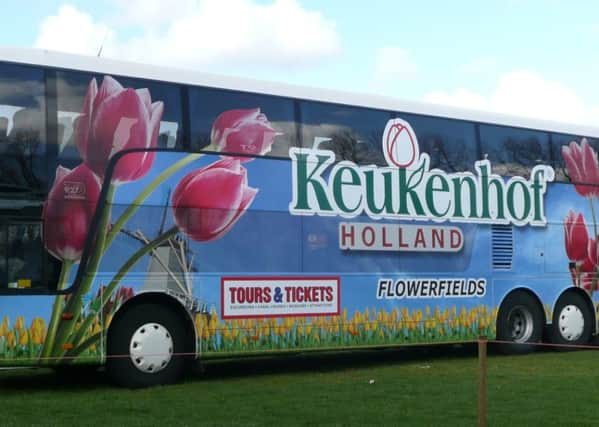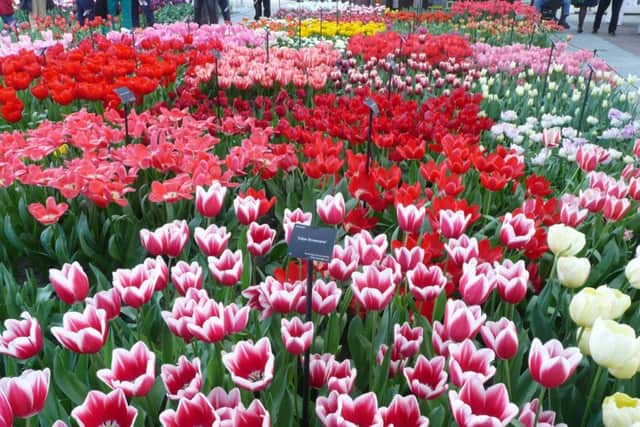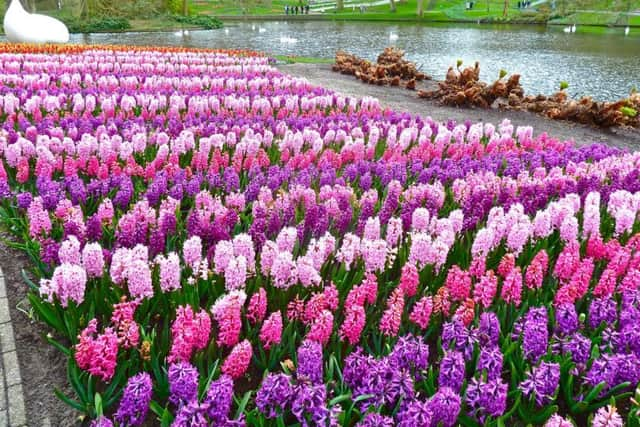Travel: Flower garden is set for another bumper season


The Keukenhof theme for 2016 is ‘The Golden Age’, the period in which Holland went through a flourishing period in the field of trade, arts and science. This was also the period in which the world was discovered and the tulip trade thrived. The mosaic will measure 250 square meters and will be planted in two layers with 100,000 tulips, muscari and crocus.
Besides the flower bulb mosaic, the Golden Age also forms an inspiration for the numerous flower shows in the Oranje Nassau Pavilion.
Advertisement
Hide AdAdvertisement
Hide AdKeukenhof now has a hundred flower bulb growers supplying bulbs to the park and some five hundred flower growers participating in the flower shows.


Over 50 million people have visited the park since it first opened and Keukenhof’s mission – both now and in the future – is to be the international and independent showcase for the Dutch floricultural sector, with a special emphasis on flowering bulbs.
Keukenhof is the platform for the Dutch floricultural sector. For the exhibitors and participants in the flower shows, it provides a superb showcase for their bulbs, flowers and plants. The park is redesigned every single year.
Keukenhof’s designer takes inspiration from the latest trends and adapts the design to suit the specific wishes of growers. This in turn provides inspiration to its visitors who gather new ideas to apply at home. In the flower shows, the arrangers also put the latest gardening ideas into practice. All of this enables Keukenhof and the growers to support and strengthen each other.
Advertisement
Hide AdAdvertisement
Hide AdKeukenhof originally focused almost exclusively on flower bulbs, but now has much more to offer. The historic park, which dates from 1857 and was designed in the English landscape garden style by Zocher, forms the perfect backdrop for the flower bulbs. Visitors can become acquainted with cut flowers, plants and tree nursery products.


Each year, thirty gardeners plant bulbs at reserved locations throughout the park. At the end of the season, these bulbs are harvested, and a new cycle of planting, blooming and harvesting begins again in the autumn.
In order to ensure that Keukenhof always has a new look, the planting is redesigned every year. The plants are carefully selected so that visitors can enjoy bulbs in full bloom throughout the entire period Keukenhof is open. The seven million flower bulbs are supplied completely free of charge by the exhibitors.
Keukenhof inspires its visitors with a range of different styles of gardens and interiors, in which flower bulbs and bulb flowers always play a key role. The different parts of the park vary from the English landscape garden to the Japanese country garden.
Advertisement
Hide AdAdvertisement
Hide AdThe contemporary Spring Meadow offers surprising perspectives and exciting vistas and brings out the very best of the ancient trees. In the natural garden, shrubs and perennials are combined with naturalised bulbs. The historic garden is home to old varieties of tulip and uses these special varieties to demonstrate the tulip’s long journey prior to its arrival in Holland.


For children, Keukenhof has a maze, a playground, a Miffy house and a petting zoo. A treasure hunt takes them along the most beautiful places in the park.
Keukenhof has its own sculpture garden. A network of artists will be exhibiting around 150 pieces. The art exhibition is characterised by a wide variety of styles, materials, figurative and abstract movements and different cultures.
The pavilions feature a changing selection of 30 flower and plant shows. Growers exhibit a wide variety of flowers and plants in all different colours and shapes.
Advertisement
Hide AdAdvertisement
Hide AdFor years, Keukenhof has reserved the thousand square-metre Beatrix Pavilion specifically for orchids. This show is the most beautiful orchid show in Europe. Another traditional leading attraction is the lily show in the Willem-Alexander Pavilion. In its 6,000 square metres, visitors can admire approximately 15,000 lilies in over 300 different varieties.


The Oranje Nassau Pavilion showcases the use of flower bulbs in interiors. It demonstrates how flower bulbs can be applied in different styles of interior design, from classic to modern. Several well-known arrangers will stage demonstrations of how the flowers can be used in surprising ways to create original bouquets.
The tulip is the distinctive icon of Holland across the world. Keukenhof of course gives the tulip the centre stage it deserves. The Willem-Alexander Pavilion is full of tulips in bloom.
An exhibition being organised in the new Juliana Pavilion shows the history of the tulip, 17th Century tulip mania and today’s tulip as a contemporary icon. The renovated Historic Garden contains extra information about the origin of the tulip.
Advertisement
Hide AdAdvertisement
Hide AdKeukenhof has a rich history, it originally began as an initiative on the part of ten flower bulb growers and exporters who created a showcase for the flower industry. In 1949, they opted for an ideal location: the gardens around Keukenhof castle.
In the 15th Century, Countess Jacoba van Beieren was the owner of the area we know today as Keukenhof. At that time the area was untouched and used only for hunting and to gather herbs for the castle’s kitchen, which is where the name Keukenhof originates. Jacoba van Beieren was born in 1401 and died in 1436.
During her brief lifetime she married four times, spent a few years in prison and lived in exile in England for some time. In 1433, she was forced to abdicate. She withdrew from public life and, at the age of just 35, she died of tuberculosis in Castle Teylingen, not far from Keukenhof.
Following the death of the Countess Jacoba van Beieren in 1436, the large Keukenhof estate passed through the hands of several wealthy merchant families, including Baron and Baroness Van Pallandt.
Advertisement
Hide AdAdvertisement
Hide AdThey invited the landscape architects Zocher, who were also responsible for the Vondelpark in Amsterdam and the gardens of Soestdijk Palace, to design a garden around their castle. The English landscape garden they created in 1857 still forms the basis for the park today.
The windmill at Keukenhof is more than a century old. It was built in Groningen in 1892, and was used to pump water out of a polder. In 1957, the Holland-America Cruise Line bought the mill and donated it to Keukenhof. The windmill provides a great viewing platform to overlook the neighbouring tulip fields in all their colourful glory.
Useful Information
Ticket prices for 2016: Adults €16, Children 0-3 years go free, Children 4-11 years €8. Parking €6. The park is open daily from 08.00 – 19.30.
Bus line 50 from Haarlem Central Station to Keukenhof. From Leiden Central Station Bus line 854 to Keukenhof and from Schiphol Airport outside Arrivals Hall 4 the bus 858 goes to Keukenhof. It is also possible to buy a combined bus and entrance ticket to the gardens enabling you to skip the queue on arriving at the gardens.